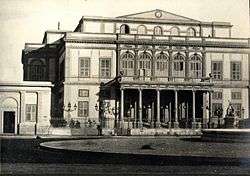Cairo Opera House
- This article refers to the Cairo Opera House built in 1988. For its predecessor, see Khedivial Opera House

The Cairo Opera House (Arabic: دار الأوبرا المصرية, Dār el-Opera el-Masreyya; literally "Egyptian Opera House"), part of Cairo's National Cultural Center, is the main performing arts venue in the Egyptian capital. Home to most of Egypt's finest musical groups, it is located on the southern portion of Gezira Island in the Nile River, in the Zamalek district west of and near downtown Cairo.
History
The opera house was inaugurated on 10 October 1988. The funds for the complex were a gift from the nation of Japan to Egypt as a result of President Hosni Mubarak's visit to Japan in April 1983. Construction began in May 1985 and lasted for three years.[1]
In October 1988, President Mubarak and Prince Tomohito of Mikasa, the younger brother of the Japanese Emperor, inaugurated the National Cultural Centre Cairo Opera House. It was the first time for Japan to stage a Kabuki show, a traditional popular drama with singing and dancing, in Africa or the Arab World.
In recognition of the Cairo Opera House, the London Royal Philharmonic Orchestra chose it as a venue for their first performance in the Middle East and Africa in January 2007. The Arabic Oud House was created in its premises before moving to a building in the old town. [2]
Khedivial Opera House

In 1869, Khedive Ismail gave instructions to build an opera house to celebrate the opening of the Suez Canal. It was called Khedivial (Royal) Opera House and was meant as a lasting and outstanding symbol of the arts of drama and music. Designed by Italian architects Avoscani and Rossi, the opera house was completed in six months, in the center of Cairo near the Azbakeya district.
The Khedive commissioned a performance which would reflect the ancient Egyptian history. French archaeologist Auguste Mariette Bey, in the Khedive’s service, wrote a plot which eventually served the respected Italian librettist Antonio Ghislanzoni as a basis for his libretto. Giuseppe Verdi was appointed to compose the music. The result was the famous opera, Aida, with its heroic quality, powerful dramatic scenes and its passionate music.
Because of delays caused by the Franco-Prussian war, the sets and costumes for the premiere of Aida could not be transported from Paris in time, and in 1869 the Opera House opened instead with Verdi's Rigoletto, one of Verdi's earlier masterpieces. Aida would receive its world premiere in Cairo in 1871. Contrary to general belief, Aida was not commissioned for the inauguration of the Suez Canal.
The Khedivial Opera House was the first on the African continent to perform world famous operas and symphonic masterpieces.
A little over a century later, in the early morning of 28 October 1971, the great Khedivial Royal Opera House was completely destroyed by a fire.
Venues and facilities
The Cairo Opera Complex consists of seven theaters, a music library, an art gallery and a museum.
.jpg)
- The Main Hall seats 1,200 people and has four levels, including orchestra seating, three tiers and a presidential box. It is used for operas and orchestra and ballet performances.[3]
- The Small Hall seats up to 500 people on a single floor, is used for chamber music and recitals and can double as a very large reception hall for important events.[4]
- The Open-Air Theatre is an acoustically designed square-shaped stage used for outdoor performances, and seats 600 people.[5]
- El Gomhouria Theatre is an exquisite theater situated near Abdeen Royal Palace. It is under the administration of the Cairo Opera House.[6]
- The Arab Music Institute has state-of-the-art technology and is well-suited to stage authentic, Arab music performances.[7]
- The Alexandria Opera House or Sayed Darwish Theatre[8]
- The Roman Amphitheatre, Alexandria which was discovered in 1963, seats up to 800. It features white marble, green marble, red granite and mosaic, arches and stone. [9][10][11]
Resident companies
|
|
|
See also
- Cairo Conservatoire
- List of concert halls
- Sherif Sonbol - (Cairo Opera House official photographer)
References
- ↑ Zuhur, Sherifa (1998). Images of Enchantment: Visual and Performing Arts of the Middle East. American Univ in Cairo Press. p. 127. ISBN 978-9774244674.
- ↑ "Pierre Cormon consacre onze semaines par an à apprendre le oud au Caire". Le Temps. 15 July 2004.
- ↑ "Main Hall". Cairo Opera House. Retrieved 15 October 2016.
- ↑ "Small Hall". Cairo Opera House. Retrieved 15 October 2016.
- ↑ "Open-Air Theatre". Cairo Opera House. Retrieved 15 October 2016.
- ↑ "El Gomhouria Theatre". Cairo Opera House. Retrieved 15 October 2016.
- ↑ "Arab Music Institute". Cairo Opera House. Retrieved 15 October 2016.
- ↑ "The Alexandria Opera House". Cairo Opera House. Retrieved 15 October 2016.
- ↑ "The Roman Amphitheatre, Alexandria". Cairo Opera House. Retrieved 15 October 2016.
- ↑ Adel Awed, Zahraa; Kamel, Seif. "The Roman Theatre (Odeum) in Alexandria". Tour Egypt. Retrieved 15 October 2016.
- ↑ The Mediterranean Medina: International Seminar. School of Architecture at Pescara from 17th to 19th of June 2004. p. 484. Retrieved 15 October 2016.
External links
- Cairo Opera House Facebook Page
- Official Cairo Opera House website
- Official Cairo Opera House Twitter Account
- Cairo Opera House government website
- official Cairo Opera Orchestra website
- official Cairo Opera Ballet Company website
- Egyptian Cultural Center: Press release "Cairo Opera"
Coordinates: 30°02′33″N 31°13′25″E / 30.04245°N 31.22353°E